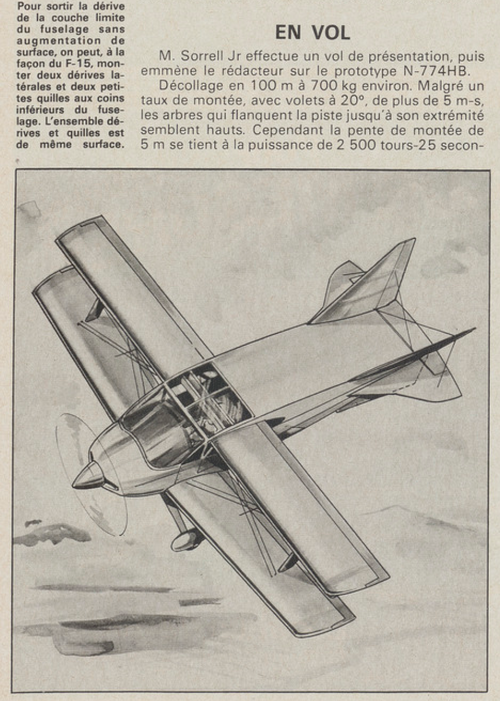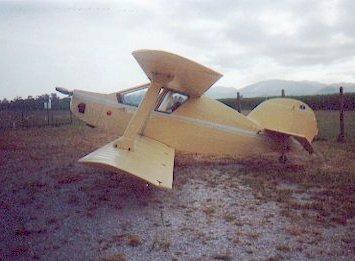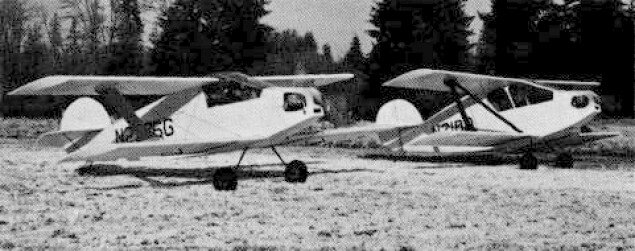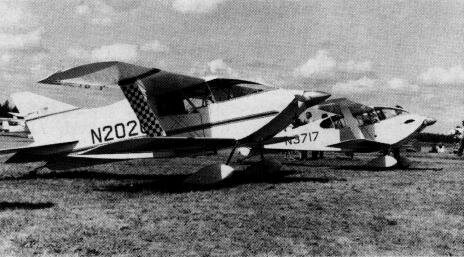You are using an out of date browser. It may not display this or other websites correctly.
You should upgrade or use an alternative browser.
You should upgrade or use an alternative browser.
Sorrell Aircraft and Projects
- Thread starter hesham
- Start date
- Joined
- 11 March 2012
- Messages
- 3,163
- Reaction score
- 3,005
Sorrel Aviation was started around 1958 by Hobart C. Sorrel and his sons John, Mark and Tim. They designed at least a dozen small airplanes.
Their first airplane was the Sorrel Dr.1: a 3/4 scale replica of a Fokker DR-1 triplane.
Hobie Sorrel also designed a couple of ultralight, single-seater biplanes of similar configuration. The wooden, single-seat SN-2 was powered by an engine of up to 36 horsepower. It first flew in 1967. Plans were sold by Sorrel Aviation and Thunderbird Aviation.
The big-engine, aerobatic Sorrel Hiperbipe followed in 1973.
The Sorrel SNS-8 Hiperlight single-seater was introduced in 1982 with a 28 hp. Rotax 277 engine. The Sorrel Negative Stagger -8 has a forward fuselage made of welded steel tubing and an aft fuselage made of aluminum tubing. The two parts of the fuselage can be unbolted for road transportation on a trailer. Wings are also made of aluminum tubing. It is limited to pilots weighing less than 230 pounds. Wingspan 22 feet.
The SNS-9 with two seats side-by-side soon followed. SNS-9 are usually powered by 50 hp. Rotax 503 engines. SNS-9 has a payload of 500 pounds. Gross weight 814 pounds. Wingspan is longer at 23.4 feet (7.1 meters).
Sorrel Aviation went defunct around 1983 with plans sales being continued by Thunderbird Aviation.
Their first airplane was the Sorrel Dr.1: a 3/4 scale replica of a Fokker DR-1 triplane.
Hobie Sorrel also designed a couple of ultralight, single-seater biplanes of similar configuration. The wooden, single-seat SN-2 was powered by an engine of up to 36 horsepower. It first flew in 1967. Plans were sold by Sorrel Aviation and Thunderbird Aviation.
The big-engine, aerobatic Sorrel Hiperbipe followed in 1973.
The Sorrel SNS-8 Hiperlight single-seater was introduced in 1982 with a 28 hp. Rotax 277 engine. The Sorrel Negative Stagger -8 has a forward fuselage made of welded steel tubing and an aft fuselage made of aluminum tubing. The two parts of the fuselage can be unbolted for road transportation on a trailer. Wings are also made of aluminum tubing. It is limited to pilots weighing less than 230 pounds. Wingspan 22 feet.
The SNS-9 with two seats side-by-side soon followed. SNS-9 are usually powered by 50 hp. Rotax 503 engines. SNS-9 has a payload of 500 pounds. Gross weight 814 pounds. Wingspan is longer at 23.4 feet (7.1 meters).
Sorrel Aviation went defunct around 1983 with plans sales being continued by Thunderbird Aviation.
Last edited:
- Joined
- 25 June 2009
- Messages
- 14,256
- Reaction score
- 4,600
Post above has variously "Sorel" and "Sorrel"... which are just wrong.
Topic title has Sorrell, the way it should be.
Model 1 "Peer Gynt 1 / Sorrell Special"
The Sorrell family saga started in 1954 in Rochester (Washington State) when C. Hobart "Hobie" Sorrell built his Model 1, also known as the "Peer Gynt 1" or "Sorrell Special". It was a two-seat open-cockpit biplane powered by a 40hp Continental A-40 (later a 65 hp Continental A-65) engine. The "Peer Gynt" was actually rebuilt from a 25 hp Henderson powered biplane which Elmer L. Smith had already modified in 1930.
The "Peer Gynt" was sold to Capt. A. G. Hagen of McChord Field, Washington, and was subsequently owned by famous writer and aviation enthusiast Peter M. Bowers of Seattle.
Topic title has Sorrell, the way it should be.
Model 1 "Peer Gynt 1 / Sorrell Special"
The Sorrell family saga started in 1954 in Rochester (Washington State) when C. Hobart "Hobie" Sorrell built his Model 1, also known as the "Peer Gynt 1" or "Sorrell Special". It was a two-seat open-cockpit biplane powered by a 40hp Continental A-40 (later a 65 hp Continental A-65) engine. The "Peer Gynt" was actually rebuilt from a 25 hp Henderson powered biplane which Elmer L. Smith had already modified in 1930.
The "Peer Gynt" was sold to Capt. A. G. Hagen of McChord Field, Washington, and was subsequently owned by famous writer and aviation enthusiast Peter M. Bowers of Seattle.
Attachments
- Joined
- 25 June 2009
- Messages
- 14,256
- Reaction score
- 4,600
Dr.1
Sorrell Aviation was established in Tenino, Wash. circa 1958 by Hobie Sorrell with his sons John, Mark and Tim.
As riggerrob rightly stated, the company's first aircraft was the Dr.1, a single-seat 3/4-size Fokker Triplane replica with a 65hp Continental A-65 or Warner engine. Several of the type were built, the first of which was [N6441C].
DFG-1 (Darn Fine Geodetic #1)
In 1958 the DFG-1 appeared. It was a small single-seat all-wood biplane with a 40hp Mercury 4-cylinder outboard engine, and a geodetic fuselage structure, which was rather uncommon. Only one DFG-1 was built [N7158].
Nieuport 17
Then in 1960, Sorrell built their second replica, a single-seat 3/4-size version of Nieuport 17 C.1 using an old 40hp Salmson AD-9 engine from 1931. Only one was built [N17C, c/n 1], and it was still in flying condition as of 2009.
Sorrell Aviation was established in Tenino, Wash. circa 1958 by Hobie Sorrell with his sons John, Mark and Tim.
As riggerrob rightly stated, the company's first aircraft was the Dr.1, a single-seat 3/4-size Fokker Triplane replica with a 65hp Continental A-65 or Warner engine. Several of the type were built, the first of which was [N6441C].
DFG-1 (Darn Fine Geodetic #1)
In 1958 the DFG-1 appeared. It was a small single-seat all-wood biplane with a 40hp Mercury 4-cylinder outboard engine, and a geodetic fuselage structure, which was rather uncommon. Only one DFG-1 was built [N7158].
Nieuport 17
Then in 1960, Sorrell built their second replica, a single-seat 3/4-size version of Nieuport 17 C.1 using an old 40hp Salmson AD-9 engine from 1931. Only one was built [N17C, c/n 1], and it was still in flying condition as of 2009.
Attachments
- Joined
- 25 June 2009
- Messages
- 14,256
- Reaction score
- 4,600
The Sorrell sons embarked on a brand new direction in 1965 with their new "SNS" series. The prefix stood for "Sorrell Negative Stagger", which indicated that the bottom wing was placed ahead of the top one (most staggered biplanes have it the other way around).
SNS-1
The SNS-1 was a single-seat all-wood negative stagger-winged homebuilt biplane with a 18hp Cushman golf cart engine and a fixed conventional landing gear. Only one was built in 1965 [N2976G, c/n 1].
SNS-2 "Guppy"
The SNS-2 appeared in 1967. It was also a single-seat all-wood negative stagger-winged homebuilt biplane, similar in concept and shape to its predecessor but with a larger cockpit. One prototype was built [N2180, c/n 2], followed by the kit version called the "Guppy" because of its shape recalling that of a fish. It used a 32-hp Rotax 377 engine by default, but other types up to 36 hp were also possible. I have no idea how many were built in total. One of the photos shows an example with a modified tail fin.
SNS-1
The SNS-1 was a single-seat all-wood negative stagger-winged homebuilt biplane with a 18hp Cushman golf cart engine and a fixed conventional landing gear. Only one was built in 1965 [N2976G, c/n 1].
SNS-2 "Guppy"
The SNS-2 appeared in 1967. It was also a single-seat all-wood negative stagger-winged homebuilt biplane, similar in concept and shape to its predecessor but with a larger cockpit. One prototype was built [N2180, c/n 2], followed by the kit version called the "Guppy" because of its shape recalling that of a fish. It used a 32-hp Rotax 377 engine by default, but other types up to 36 hp were also possible. I have no idea how many were built in total. One of the photos shows an example with a modified tail fin.
Attachments
- Joined
- 25 June 2009
- Messages
- 14,256
- Reaction score
- 4,600
SNS-3 "Biggy Rat"
Also built in 1967, the SNS-3 was a sturdier development of the previous two models, powered by a 125-hp converted Lycoming O-290-G engine. It was a bullet-nosed speedster using the same fuselage profile, but with a windshield fairing right down to spinner, and no tapering of the side frames at the tail. Only one was built [N3717, c/n 3].
SNS-4 (SNS IV)
In 1970, the SNS-4 appeared. It was a side-by-side two-seater "touring" model with a 125-hp converted Lycoming engine, a wider fuselage, a plush upholstery job, an auxiliary fuel tank behind the right seat, and a different empennage. Apparently, only one was built [N2026, c/n 202].
SNS-5 "Golden Condor"
In the early 1970s, Sorrell put out yet another prototype, the SNS-5 [N6997, c/n 102]. Very little is known about it as it crashed non-fatally in 1974 from complete engine failure. I haven't been able to find any photos of it.
"Wenoso" (Sorrell-Robinson)
Out of the SNS sequence, the patriarch "Hobie" Sorrell produced a new aircraft circa 1972 called the "Wenoso". It was a single-seat enclosed cockpit monoplane with full-cantilever mid-wing and powered by a 65hp Continental engine. Although built by Hobie Sorrell, it apparently involved another builder since it's usually found as a "Sorrell-Robinson" type. The single "Wenoso" [N1041] was eventually rebuilt in 1990, but it crashed fatally that same year.
Also built in 1967, the SNS-3 was a sturdier development of the previous two models, powered by a 125-hp converted Lycoming O-290-G engine. It was a bullet-nosed speedster using the same fuselage profile, but with a windshield fairing right down to spinner, and no tapering of the side frames at the tail. Only one was built [N3717, c/n 3].
SNS-4 (SNS IV)
In 1970, the SNS-4 appeared. It was a side-by-side two-seater "touring" model with a 125-hp converted Lycoming engine, a wider fuselage, a plush upholstery job, an auxiliary fuel tank behind the right seat, and a different empennage. Apparently, only one was built [N2026, c/n 202].
SNS-5 "Golden Condor"
In the early 1970s, Sorrell put out yet another prototype, the SNS-5 [N6997, c/n 102]. Very little is known about it as it crashed non-fatally in 1974 from complete engine failure. I haven't been able to find any photos of it.
"Wenoso" (Sorrell-Robinson)
Out of the SNS sequence, the patriarch "Hobie" Sorrell produced a new aircraft circa 1972 called the "Wenoso". It was a single-seat enclosed cockpit monoplane with full-cantilever mid-wing and powered by a 65hp Continental engine. Although built by Hobie Sorrell, it apparently involved another builder since it's usually found as a "Sorrell-Robinson" type. The single "Wenoso" [N1041] was eventually rebuilt in 1990, but it crashed fatally that same year.
Attachments
- Joined
- 25 June 2009
- Messages
- 14,256
- Reaction score
- 4,600
The SNS series evolved in the "Hyperbipe" series.
SNS-6 "Hiperbipe"
Introduced in 1973, the two-seat SNS-6 "Hiperbipe" (a coined name meaning HIgh PERformance BIplane) was still a characteristic SNS type with its trademark negative stagger. However, it differed notably for being aerobatic. A sole prototype [N66S, c/n 203], it was powered by a 180-hp Lycoming O-360 engine.
SNS-7 "Hiperbipe"
The SNS-7 prototype was the former SNS-3 "Biggy Rat" [N3717, c/n 3] updated to new "Hiperbipe" configuration, with deluxe upholster and finish. Subsqequent SNS-7 aircraft [N774HB, c/n 204, etc.] were the production version of the SNS-6/-7 prototypes, also powered by 180-hp Lycoming O-360 engines.
SNS-6 "Hiperbipe"
Introduced in 1973, the two-seat SNS-6 "Hiperbipe" (a coined name meaning HIgh PERformance BIplane) was still a characteristic SNS type with its trademark negative stagger. However, it differed notably for being aerobatic. A sole prototype [N66S, c/n 203], it was powered by a 180-hp Lycoming O-360 engine.
SNS-7 "Hiperbipe"
The SNS-7 prototype was the former SNS-3 "Biggy Rat" [N3717, c/n 3] updated to new "Hiperbipe" configuration, with deluxe upholster and finish. Subsqequent SNS-7 aircraft [N774HB, c/n 204, etc.] were the production version of the SNS-6/-7 prototypes, also powered by 180-hp Lycoming O-360 engines.
Attachments
-
 SNS-7 'Hyperbipe' prototype.jpg113.9 KB · Views: 2
SNS-7 'Hyperbipe' prototype.jpg113.9 KB · Views: 2 -
 page87.jpg853.5 KB · Views: 3
page87.jpg853.5 KB · Views: 3 -
 page86.jpg955 KB · Views: 3
page86.jpg955 KB · Views: 3 -
 page85.jpg701.6 KB · Views: 5
page85.jpg701.6 KB · Views: 5 -
 SNS-6.jpg347 KB · Views: 4
SNS-6.jpg347 KB · Views: 4 -
 1024px-Sorrell_Hiperbipe.jpg129.9 KB · Views: 4
1024px-Sorrell_Hiperbipe.jpg129.9 KB · Views: 4 -
 hiperbipe.jpg106.8 KB · Views: 2
hiperbipe.jpg106.8 KB · Views: 2 -
 Sorrell_Hiperbipe_SNS-7_AN0326390.jpg325.4 KB · Views: 2
Sorrell_Hiperbipe_SNS-7_AN0326390.jpg325.4 KB · Views: 2 -
 HiperBipe1.jpg16.5 KB · Views: 2
HiperBipe1.jpg16.5 KB · Views: 2 -
 Sorrell_SNS-7_Hiperbipe.jpg218.6 KB · Views: 3
Sorrell_SNS-7_Hiperbipe.jpg218.6 KB · Views: 3
- Joined
- 25 June 2009
- Messages
- 14,256
- Reaction score
- 4,600
SNS-8 "Hiperlight" & "Hiperlight EXP"
Introduced in 1982, the SNS-8 was a single-seat biplane ultralight designed at the request of the US Rotax engine distributor. Available in kit form, it was sold initially by Sunrise Aircraft of Sheridan, Oregon, then produced by Thunderbird Aviation of Ray, Michigan. 603 examples were produced.
SNS-9 "Hiperlight EXP II"
The SNS-9 was the two-seat version of the SNS-8. It appeared in 1985, and apparently only 26 were produced. It was available in kit form and remained in production at least until 2015 by Thunderbird Aviation, and could use various engines including the Jabiru 2200.
SNS-10 "Intruder"
The SNS-10 is supposed to be a beefed up single-seat aerobatic development of the "Hiperlight" for sport and competition purposes. The project was announced as early as 1987, but was still described as "in development" on the Mark Sorrell Co.'s site in 2006.
Introduced in 1982, the SNS-8 was a single-seat biplane ultralight designed at the request of the US Rotax engine distributor. Available in kit form, it was sold initially by Sunrise Aircraft of Sheridan, Oregon, then produced by Thunderbird Aviation of Ray, Michigan. 603 examples were produced.
SNS-9 "Hiperlight EXP II"
The SNS-9 was the two-seat version of the SNS-8. It appeared in 1985, and apparently only 26 were produced. It was available in kit form and remained in production at least until 2015 by Thunderbird Aviation, and could use various engines including the Jabiru 2200.
SNS-10 "Intruder"
The SNS-10 is supposed to be a beefed up single-seat aerobatic development of the "Hiperlight" for sport and competition purposes. The project was announced as early as 1987, but was still described as "in development" on the Mark Sorrell Co.'s site in 2006.
Attachments
- Joined
- 25 June 2009
- Messages
- 14,256
- Reaction score
- 4,600
The Mark Sorrell Co., LLC, Rochester, Wash., with Mark Sorrell as owner, and John Sorrell as "master builder", continued to own the production rights to some of the old Sorrell Aviation designs and at least tentatively marketed the SNS-7 and SNS-10. — The production rights for the SNS-7 "HiperBipe" were acquired from the Mark Sorrell Co. by Skies The Limit Enterprises, Inc. (owner: Ken Rivers) circa 2005.
And now for some Sorrell bits and pieces...
"Colt"
One Otto M. Sorrell, also from Rochester, Washington, produced his first aircraft in 1954, just like Hobie (who was likely his brother). The "Colt" was a single-seat open-cockpit homemade biplane with a 65hp Continental A-65 engine. I haven't been able to find a photo of it so far, although it is said to have flown repeatedly at the time.
"Cool Crow 1"
Nicknamed "The Flying Bathttub" for obvious reasons, this 1960 prototype was Otto Sorrell's second creation [N5087K, c/n 01]. It was a single-seat open-cockpit "ultra-ultralight" high-wing monoplane with geared-down chain-saw motor and tricycle gear, inspired by the famous 1924 Dormoy "Bathtub" (ancestor of the Aeroncas). The "Cool Crow" is now preserved in a museum.
"Bathtub"
Although not from any of the Sorrells, further development came in 1978 from Michael Kimbrel, Oakville, Wash., when he introduced his "Bathtub", a tailwheel version of Otto Sorrell's "Cool Crow" with a Volkswagen engine. 400 sets of drawings were sold to home-builders, but how many were actually built is not known.
JA-3-80
This uncertificated homebuilt [N68654, c/n 1] was built in 1972 by John Sorrell (without his brothers), but crashed fatally in 1974 from loss of control by an unqualified pilot. As for the "Golden Condor", which also crashed that same year, I haven't been able to find any photo of it so far.
And now for some Sorrell bits and pieces...
"Colt"
One Otto M. Sorrell, also from Rochester, Washington, produced his first aircraft in 1954, just like Hobie (who was likely his brother). The "Colt" was a single-seat open-cockpit homemade biplane with a 65hp Continental A-65 engine. I haven't been able to find a photo of it so far, although it is said to have flown repeatedly at the time.
"Cool Crow 1"
Nicknamed "The Flying Bathttub" for obvious reasons, this 1960 prototype was Otto Sorrell's second creation [N5087K, c/n 01]. It was a single-seat open-cockpit "ultra-ultralight" high-wing monoplane with geared-down chain-saw motor and tricycle gear, inspired by the famous 1924 Dormoy "Bathtub" (ancestor of the Aeroncas). The "Cool Crow" is now preserved in a museum.
"Bathtub"
Although not from any of the Sorrells, further development came in 1978 from Michael Kimbrel, Oakville, Wash., when he introduced his "Bathtub", a tailwheel version of Otto Sorrell's "Cool Crow" with a Volkswagen engine. 400 sets of drawings were sold to home-builders, but how many were actually built is not known.
JA-3-80
This uncertificated homebuilt [N68654, c/n 1] was built in 1972 by John Sorrell (without his brothers), but crashed fatally in 1974 from loss of control by an unqualified pilot. As for the "Golden Condor", which also crashed that same year, I haven't been able to find any photo of it so far.
Attachments
Similar threads
-
ICX Aviation X-Avia (LC-3) - An Amerikanized Yak-40 effort of late 70s
- Started by VictorXL188
- Replies: 6
-
PANNAP - Panavia New Aircraft Project
- Started by boxkite
- Replies: 10
-
-
Teledyne Ryan VTOL/VSTOL/STOL projects (NOT liftfan/Fan-In-Wing)
- Started by EEP1A
- Replies: 20
-
Robertson X-1 STOL Airplane Project of 1958
- Started by hesham
- Replies: 5




































